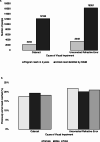Assessment of eye health programme reach by comparison with rapid assessment of avoidable blindness (RAAB) survey data, Talagang, Pakistan
- PMID: 38987673
- PMCID: PMC11238346
- DOI: 10.1186/s12875-024-02503-4
Assessment of eye health programme reach by comparison with rapid assessment of avoidable blindness (RAAB) survey data, Talagang, Pakistan
Abstract
Background: The purpose of this study was to quantify how much of the burden of visual impairment (VI) and unmet need in Talagang, identified by Rapid Assessment of Avoidable Blindness (RAAB) survey data, has been addressed by Community Eye Health (CEH) programme efforts.
Methods: A RAAB survey was carried out in November 2018, with 2,824 participants in Talagang Tehsil, Punjab, Pakistan, aged 50 and over. Census data were used to extrapolate survey data to the population. Alongside this, a CEH programme was launched, consisting of community eye screening, and onward referral to rural health centres, secondary or tertiary ophthalmological services, as required. This health intervention aimed to address the eye care needs surfaced by the initial survey. From 2018 to 2022, 30,383 people aged 50 or over were screened; 14,054 needed referral to further steps of the treatment pathway and more detailed data collection. Programme data were compared to estimates of population unmet needs. Main outcome measures were prevalence of VI, and proportion of need met by CEH Programme, by cause and level of VI.
Results: Among those aged 50 and over, 51.0% had VI in at least one eye. The leading causes were cataract (46.2%) and uncorrected refractive error (URE) (25.0%). In its first four years, the programme reached an estimated 18.3% of the unmet need from cataract, and 21.1% of URE, equally in both men and women.
Conclusions: Robustly collected survey and programme data can improve eye health planning, monitoring and evaluation, address inequities, and quantify the resources required for improving eye health. This study quantifies the time required to reach eye health needs at the community level.
Keywords: cataract; community health worker; epidemiology; eye health; global ophthalmology; primary eye care; programme; refractive error; survey.
© 2024. The Author(s).
Conflict of interest statement
The authors have made the following disclosures: AB: Co-founder - Peek Vision; SLA, EW and MK: Financial support - Peek Vision; ZA: Financial support - CBM International. No personal financial support related to this manuscript.
Figures





Similar articles
-
Nationwide Rapid Assessment of Avoidable Blindness (RAAB) in Armenia.Ophthalmic Epidemiol. 2024 Feb;31(1):62-69. doi: 10.1080/09286586.2023.2187068. Epub 2023 Mar 5. Ophthalmic Epidemiol. 2024. PMID: 36872562
-
Rapid assessment of avoidable blindness in Iran.Ophthalmology. 2011 Sep;118(9):1812-8. doi: 10.1016/j.ophtha.2011.01.049. Epub 2011 May 14. Ophthalmology. 2011. PMID: 21571371
-
A rapid assessment of avoidable blindness in Southern Zambia.PLoS One. 2012;7(6):e38483. doi: 10.1371/journal.pone.0038483. Epub 2012 Jun 21. PLoS One. 2012. PMID: 22737211 Free PMC article.
-
Causes of blindness and vision impairment in 2020 and trends over 30 years, and prevalence of avoidable blindness in relation to VISION 2020: the Right to Sight: an analysis for the Global Burden of Disease Study.Lancet Glob Health. 2021 Feb;9(2):e144-e160. doi: 10.1016/S2214-109X(20)30489-7. Epub 2020 Dec 1. Lancet Glob Health. 2021. PMID: 33275949 Free PMC article.
-
Rapid Assessment of Avoidable Blindness: looking back, looking forward.Br J Ophthalmol. 2019 Nov;103(11):1549-1552. doi: 10.1136/bjophthalmol-2019-314015. Epub 2019 Jul 2. Br J Ophthalmol. 2019. PMID: 31266777 Free PMC article. Review.
References
-
- Bourne R, Steinmetz J, Flaxman S et al. Trends in prevalence of blindness and distance and near vision impairment over 30 years: an analysis for the global burden of Disease Study. Lancet Glob Health. 2020. Accessed via the IAPB Vision Atlas (https://www.iapb.org/learn/vision-atlas) - PMC - PubMed
Publication types
MeSH terms
Grants and funding
LinkOut - more resources
Full Text Sources
Miscellaneous
